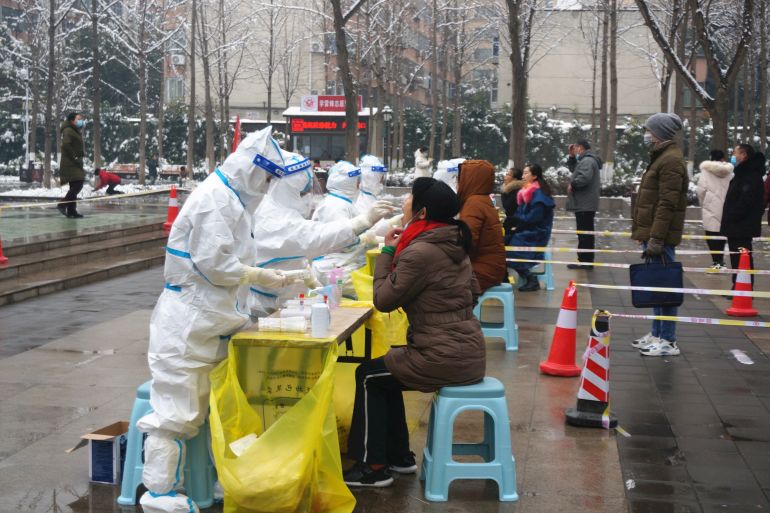Amid Ukraine crisis, China’s ‘Zero COVID’ weighs on global growth
Beijing’s strict pandemic policies add to supply chain and inflation risks amid economic fallout of war in Ukraine.

As war in Ukraine and sanctions on Russia threaten global economic growth, the future of China’s “dynamic zero COVID” policy is under scrutiny as a factor in supply chain disruptions and rising inflation.
While the rest of the world is opening borders and learning to live with COVID-19, China’s elimination strategy – which involves using mass testing and tracing, border controls and snap lockdowns to contain the virus – has weighed on the post-pandemic economic recovery at home and overseas.
Keep reading
list of 4 itemsHow will rewriting Chile’s constitution change the country?
Ukraine, inflation, Biden’s first State of the Union – a timeline
Latest Ukraine updates: UNGA votes to demand Russian withdrawal
The restrictions have slowed domestic spending across China, set off a brain drain in Hong Kong, and triggered export disruptions that have been blamed for fuelling rising inflation worldwide.
In January, IMF Managing Director Kristalina Georgieva said Beijing’s pandemic strategy increasingly looked like “more of a burden” to the economy.
“At a time of heightened market volatility, any possible news on another more serious COVID outbreak in China will stir market reactions and add further to commodity price volatility,” said Tommy Wu, lead economist at Oxford Economics in Hong Kong.
GlobalData has forecast a 4.6 percent global inflation rate in 2022, compared with 3.6 percent in 2021, revising its inflation estimates upward for many of China’s major export destinations, including the US, Germany, the Netherlands, and Vietnam.
The crisis in Ukraine has exacerbated pre-existing global inflation fears, with oil prices surging above $100 a barrel for the first time since 2014.
China has declined to condemn Russia, the world’s second-largest natural gas producer and third-largest oil producer, over its invasion of Ukraine, and instead, has called on all parties to “exercise restraint”.
Inflationary pressures
“China supply-chain disruptions have driven up input costs for firms across sectors who’ve had to pass the higher cost of production on to consumers thereby driving up global good prices,” Gargi Rao, a GlobalData economic research analyst, told Al Jazeera, listing the US, Hong Kong, Japan, Vietnam, South Korea, and India as among the economies most vulnerable to China’s supply chain disruptions.
“To tame these inflationary pressures, central banks in major economies are likely to hike policy rates. However, even after hiking policy rates, inflationary pressure may persist as the rise in price level is mainly driven by supply shortages.”
While the economic impact of zero COVID pales in comparison to the potential fallout of the war in Ukraine, the unpredictability and suddenness of disruptions can have costly, albeit short-lived consequences.
A lockdown in the southern Chinese city of Baise last month interrupted the transportation of aluminium ingots and raw materials to factories, triggering export delays that sent prices to a 14-year high.
“Supply chain interruptions in China don’t discriminate by industry or geographic region,” Trivium China analyst Taylor Loeb told Al Jazeera.
“They are unpredictable and have happened all over the country. The uncertainty will continue – not around the policy per se, but around the fact that the ‘when’ and ‘where’ of outbreaks, and the lockdowns that follow them, are unpredictable.”
Apparently concerned about the economic fallout, Beijing has in recent months experimented with more targeted lockdowns that have focused on specific venues or neighbourhoods rather than whole cities.
“The impact of lockdowns in China on supply chains will depend on how the lockdowns are implemented,” Tianlei Huang, a research fellow at the Peterson Institute for International Economics in Washington, DC, told Al Jazeera.
Huang cited Shanghai – which locked down specific buildings and locations rather than the entire city – as a good example of an effective targeted lockdown strategy.
“With well-targeted lockdowns, economic activity interruptions can be minimised,” he said.
Wu of Oxford Economies said a more targeted approach would help “keep production running as much as possible in case of COVID outbreaks.”

A recent explosion of cases in Hong Kong has cast further doubt on the sustainability of a strict “zero COVID” stance. After keeping infections near zero for most of the pandemic, the international financial centre is reporting more than 30,000 cases and 100 deaths each day. Under the city’s most draconian pandemic restrictions since the pandemic began, businesses are facing months of forced closures, supermarket shelves are being stripped bare, and international talent is heading for the door.
Despite repeated flare-ups in infections, mainland China has reported fewer than 4,700 deaths throughout the pandemic, one of the lowest death tolls in the world.
This week, Zeng Guang, former chief epidemiologist at the Chinese Centre for Disease Control and Prevention, hinted that Beijing could be reconsidering its “zero COVID” policy. In a social media post, Zeng said the policy “will not remain forever” and that China’s long-term goal would involve co-existing with the virus.
“In the near future, at the right time, the roadmap for Chinese-style co-existence with the virus should be presented,” said Zeng, expressing hope that Beijing would adopt a reopening policy “that is flexible yet manageable, one that benefits from China’s whole-of-society system yet also learns from others’ successes”.
So far, Beijing has yet to signal any such change.
Wu Zunyou, chief epidemiologist with the Chinese Centre for Disease Control and Prevention, last month told Chinese state media that the country would not adjust its policy for the time being.
Loeb of Trivium China said the economic effect of Beijing’s strategy has not been as severe as many had predicted.
“The sanctions on Russia, and what is likely to be Russia’s prolonged isolation from developed economies, are going to cause long-term pain, particularly in energy and other commodities,” he said. “But for China, if post-Omicron trends continue, the frequency of supply chain disruptions will only decrease.”